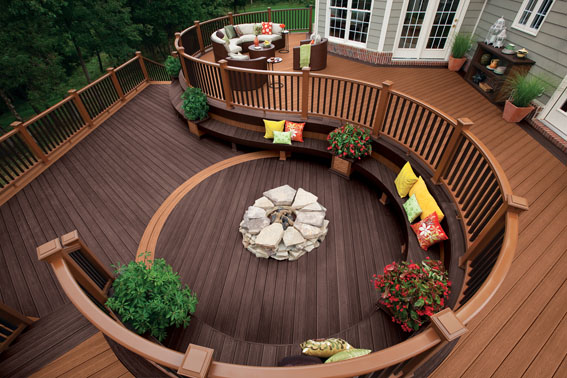Considering building a new patio or deck to enjoy a lovely weather but want to be mindful of the environmental impact? Millions of homeowners across the country continue to use”standard” patio materials like asphalt, concrete and cement to support their patios because they’ve proven their worth time and again but is it time for new awareness?
Problems With the Status Quo
Unfortunately, your asphalt, concrete or cement patio is liable to be among the least sustainable elements of your property. In fact, standard patio-building materials present several key problems for environmentally conscious homeowners.
For starters, these surfaces all contain synthetic or petroleum-based components that require huge amounts of energy to fabricate. The amount of energy that goes into a given product’s production is known as “embodied energy,” and it’s one of the main factors that contribute to its overall environmental footprint.
Asphalt, concrete and cement also contain toxins that can leak into your lawn, groundwater and pool during bouts of rain. What’s more, these nonporous “hardscape” surfaces can direct rainwater in concentrated streams and cause surprising amounts of damage to your yard. In the long run, this runoff could even eat away at your home’s foundation.
You don’t want to find out what that looks like.
A Gentler Way
Fortunately, there are several sustainable alternatives that feature lower levels of embodied energy as well as a more sustainable product life cycle. Some of these alternatives are “natural” materials that incorporate locally sourced or low-impact raw materials like soil cement. Others are reused materials like synthetic wood made from recycled plastic. Still others use “sustainable sourcing” guidelines to ensure that they’re brought to your backyard with minimal environmental impact. Natural wood sourced in accordance with the bylaws of the Forest Stewardship Council is a perfect example of such a product.
In other words, your desire to build a patio from sustainable materials doesn’t have to cramp your style. With such a wide range of options at your disposal, your earth-friendly patio can take virtually any form imaginable.
Three Steps to Superior Product Selection
Of course, you’ll need to select high-quality, low-impact materials before getting started. To evaluate the sustainable materials that you’ll ultimately put into your new patio, state and federal environmental assessors adhere to three easy steps.
1. Research
Not all sustainable patio products are created equal. As such, assessors pay attention to several key metrics that “grade” a material’s environmental impact. The most important of these are its recycled content composition, embodied energy level and durability rating. In addition, they may source impartial assessments or reviews from third parties that discuss the material’s environmental impact as well as its compatibility with established building codes and local regulations.
2. Evaluation
Environmental assessors test the claims of each material’s manufacturers by comparing similar products and testing their functionality in end-use settings. For starters, they typically inspect materials side by side to compare embodied energy levels, recycled material compositions and other key metrics. They may also subject each material to a functionality test that evaluates its performance as a patio component. Finally, they conduct life cycle assessments or LCAs that measure a product’s total environmental impact from the moment of its manufacture to the day that it’s thrown away.
3. Selection
This process sums up the findings of the first two steps and assigns a score to each evaluated material. These ratings may fluctuate in accordance with the specific functions or uses of a given material.
Friendly Materials
When it comes to standard patio-building materials, nonporous surfaces and toxins are only part of the problem. The inherent wastefulness of using new raw materials to create finished asphalt, concrete and cement patio stones makes such materials considerably less sustainable.
As a rule of thumb, it pays to use as much recycled material as possible in your sustainable patio. This has the added bonus of being quite cost-effective. Reused materials like synthetic wood, recycled brick and glass, and even cement made from landfill soil will cost you considerably less over the life of your patio. What’s more, such materials are often easy to swap out and replace. They generally don’t require expensive or customized replacement stones.
Local materials can be a boon as well. Locally sourced stones, bricks and recycled materials tend to be cheaper and easier to transport than standard building blocks. Since they don’t come from halfway around the globe, they’re far more sustainable to ship as well.
It’s not hard to turn your patio into an environmentally-friendly garden spot that won’t destroy your yard with toxins or runoff. By selecting local materials that have little embodied energy and plenty of reused components, you’ll save money and do your part to create a more sustainable planet in the process.
AUTHOR: Brian Sonnier works for Lone Star Patio Builders in Houston, TX. They design and build outdoor kitchens for homeowners throughout southern Texas.
Photo source: Trex Decking

 Remodeling Green – 5 Tips You Wish You Heard Before you Started
Remodeling Green – 5 Tips You Wish You Heard Before you Started What’s a Green Home and Why Do We Care?
What’s a Green Home and Why Do We Care? Vanadium: The Next Big Thing for Solar Energy Storage
Vanadium: The Next Big Thing for Solar Energy Storage